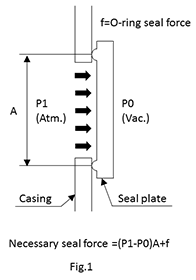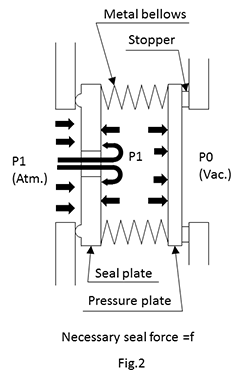A vacuum gate valve is required to have the function of isolating and sealing a vacuum and the atmosphere or vacuum spaces different in pressure for surface treatment of various substrates in vacuum equipment. In line with the recent scaling up in size of vacuum equipment, there is an increasing demand for upsizing of the opening sizes of vacuum gate valves. The vacuum gate valves can be classified into the following three specifications according to the operating direction of the valve body.。
As is commonly known, the atmospheric pressure is a pressure corresponding to the weight of about 9.8N (≒1kgw) per square centimeter at approximately 100kPa. Assuming that the opening size of a vacuum gate valve (rectangular) is 300mm × 2000mm, the force (F) to seal the valve body in the conventional valve structure of [1] Negative pressure specification shown above is calculated with the cross-sectional model in Fig. 1 as follows:

F=(P1-P0)A+f
≒ 100kPa×0.6m2+10kN=70kN(≒7ton)
It is necessary to have as much sealing force as the gross weight (8 ton) of a 4-ton truck with cargo. In other words, a valve that operates 1,000,000 times with this force needs to be large in weight and size with improvement in the rigidity of the valve body, with the result that manufacturing costs will increase, leaving only negative effects from a manufacturing perspective.
Therefore, IRIE KOKEN has developed a “differential pressure cancellation valve” in order to solve the above problems in upsizing the openings of gate valves.
A cross-sectional view of the above construction is given in Fig. 2 below. In the case of a “negative pressure specification,” the working conditions of which are the severest for valves, since the atmospheric pressure is introduced into the metal bellows of the valve plate from the “introduction port” of the seal plate, the differential pressure becomes nonexistent between the valve seat side of the seal plate and the inside of the metal bellows.
Although the metal bellows have an effective pressure receiving area (approximately the intermediate of the inner and outer diameters), since there is no pressure differential in this area, no differential pressure acts on the seal plate, where forces are brought into a state of equilibrium.
That is to say, due to this differential pressure cancellation mechanism, the force to seal the valve body can be reduced significantly.
At this time, when the seat force required (F) is calculated on the assumption that the effective pressure receiving area of the metal bellows is equivalent to the pressure receiving area of the seal plate:
F=(P1-P0)A+f=(P1-P1)A+f=f
the O-ring’s compression force alone will be sufficient. The non-seal side plate is subjected to a differential pressure, but due to the displacement of the bellows, it strikes against the opposite surface on the valve seat side of the valve case, where the differential pressure of the effective area of the metal bellows is absorbed. Therefore, the following effects can be obtained.

Note 1) In products, the seal drive is performed by an air cylinder that is installed in the metal bellows.
Note 2) In the case of rectangular type gate valves, a round-shaped metal bellows is mounted in the valve plate; therefore, the effective pressure receiving area of the metal bellows is approximately 70% of the pressure receiving area of the valve plate, so that the effect of cancelling the differential pressure is also approximately 70%.